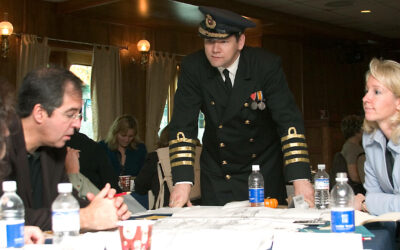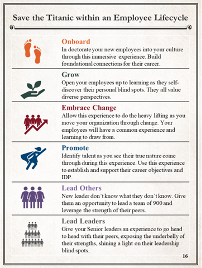You want your employees to develop leadership skills to achieve your business results. You know that most leaders and employees do not have individual development plans, but you want them to be constantly developing leadership skills so they become more capable team members.
What if you could reinforce the employee’s responsibility by ensuring that they develop their capabilities rather than having them rely upon their leaders?
The biggest problem with programs for developing leadership skills in the workplace is that most organizations rely on videos or training programs. Too often we believe that learning about leadership will automatically translate into leader development. The reality is that your leaders learn to lead by leading.
What if you could help your employees become more motivated to lead, build their capabilities, all while achieving or exceeding results?
HOW DO YOU CREATE TEAM LEADERS?
To ensure leadership development actually happens in the workplace there are a few key ingredients:
• deliberate practice
• accountability partners
• clear development priorities that are meaningful to the leader
• application to a project
Without these elements, leader development becomes less likely.
DELIBERATE PRACTICE
Deliberate practice helps the leader target a specific development priority and enables the leader to practice the process and the components of a leadership behavior.
Deliberate practice is an effective way of bridging the insights gleaned from leadership development programs into the day-to-day behavior of the leader. Without deliberate practice, the learning remains as a piece of knowledge. Learning is typically lost within 24 to 48 hours unless supported with a tracking and implementation process that causes the leader to apply their learning in the workplace.
ACCOUNTABILITY PARTNERS
Accountability partners support the shift from learning as an insight, into the application of learning to drive business results. Accountability partners ideally go through a learning program together and meet weekly to ensure the application of specific learning insights from the program. Accountability partners create a psychologically safe place for leaders to focus on how they can implement their learning, which is where the actual value of learning lives. Without the application of learning, learning programs often fail to impact the business results or cause leadership behavior change.
DEVELOPMENT PRIORITIES
Development priorities focus the leaders and teams on the immediate benefit of developing leadership strength and capabilities. Typically an employee will want to have one to three development priorities identified. These development priorities become part of the employee’s individual development plan (IDP) or personal growth plan (PGP).
The reality is that few employees ever have meaningful IDP’s or PGP’s, and if they do have an IDP it is typically completed just before a performance review or year and development planning conversation. Development priorities that are identified, tracked, and achieved motivate individuals to continue with learning and development. The absence of development priorities can mean that employees do not feel invested in by their leader and increase the likelihood of turnover in the organization.
APPLICATION TO A PROJECT
Impact projects are by far the most effective way of developing leaders. An impact project focuses the leader on developing how they lead a project, conversation, or task. Impact projects with specific measurement create an ideal feedback loop for the leaders to see their progress and their opportunity.
Ideally you want the impact project to deliver a clear impact on an annual basis that shows the dollar value of the leadership development. This figure helps both the employee and their leader understand the value of developing new behaviors, skills, and capabilities. Quite often leaders are woefully unaware of the benefit to themselves, their team, and the organization of leading differently.
The impact project works best when the project requires the development priorities of the individual to create the impact. When the development priorities are not required to produce the impact projects results, the employee can avoid the developmental growth which reduces the effectiveness of the project for development and slows growth.
WHAT LEADERSHIP DEVELOPMENT METHOD WORKS BEST IN AN ORGANIZATION?
The most common way of developing leaders is not necessarily the most effective. With so many different approaches, the effectiveness of the approach for leader development becomes most important.
PEER-MENTORING CIRCLES
The most effective way of developing leaders as researched by Harvard Business School is a peer mentoring circle. Over 250% more effective than a traditional training program, the peer mentoring circle empowers leaders to self-develop. A common process for rapid leader development is award-winning leadership development programs like Save the Titanic. Participants who use peer mentoring brain trusts to continue leader and team development after the immediate learning experience. Peer mentoring circles drive immediate business results by targeting the challenges the leaders are facing and engage their peers to share lived experience from which all leaders can learn.
IMPACT PROJECTS
Impact projects where leaders are responsible to create a specific result by leading differently generate rapid leader development and business impact. Ideally impact projects require the individual to change behavior on specific ways of leading to achieve the result. For example, if the leader’s development priority is to present more confidently to leaders above them, then the impact project would impact the larger value chain and involve leaders above and across so that the leader gains practice and experience influencing and aligning other leaders.
Impact projects are most commonly found in executive development programs yet tend to be limited to a case-style challenge that all participants work in teams to impact. The best impact projects are done individually or in small teams to achieve specific business results and are measured with existing performance indicators that provide ongoing feedback. Typically you want to have support for the leaders as they confront their behavior change; immediate support from an impact coach creates a psychologically safe space to apply new skills in the workplace and with their team. Impact projects remain a highly valuable way to understand a leader’s readiness for their next leadership challenge and for other leaders to understand their leadership pipeline.
IMMERSIVE LEARNING EXPERIENCES
Immersive learning experiences allow the participants to have full control and choice in their learning experience. This means the learning insights are specific to the participants themselves and drive immediate development based on the activity of the individual leader. The immersive nature of these experiences tap into the learning processes involved in the retention and recall of information, and sets up a profoundly important learning application process that transforms the individuals behavior. Uncovering blind spots and receiving feedback based on action or inaction during the experience creates rapid leader development.
EXECUTIVE EDUCATION/MANAGEMENT DEVELOPMENT PROGRAMS
Executive education or management development programs offered at a corporate level engage leaders to understand to create social connections across the organization and cultural norms. The best of these programs focusses on deliberate practice and impact projects, well most of them focus on more traditional training approaches by outside vendors and some internal leaders.
Often associated with universities or large-scale training enterprises, development programs of this nature typically cover a series of topics related to the leadership competencies of that organization. Their effectiveness at driving behavior change and creating measurable impact on the business are reflected in the program design.
The easiest way to know if a management development program will be effective is often by looking at how the modules are organized. If the participants are only in sessions and do little between sessions, the program will be less effective because it is more content-focused than process-focused. The more process-focused an executive development program is the more the leader grows through consistent deliberate application, achieving real business impact.
TRADITIONAL LEADERSHIP DEVELOPMENT PROGRAMS
Traditional leadership development programs are typically offered by external vendors or an internal subject matter expert. These programs typically focus on a core model of leadership that may or may not fit the day-to-day demands of the leaders involved.
The more transferable the content of the program is to the day-to-day reality of the leader- the more effective it will be. Once-off leadership development programs typically fail to acknowledge the complexities of leading inside most organizations. Leaders often only take away one or two core ideas from the session without applying those ideas; little behavior change or impact can be expected.
This approach is quite convenient for a training department who are measured by number of training days per year and is most effective when specific skills are being learned (for example, behavioral-based interviewing). Traditional leadership development programs are best related to an individual’s development plan when they are seeking to build specific skills capabilities or competency. They can be immediately improved by pairing an accountability partner or by having their leader more actively engaged in the application of learning from the program. As a leader, you want to make sure that the individual immediately applies what they learned in the program and ideally teaches others to learn these skills.
TEAM BUILDING EXERCISES
Team building can develop leaders quickly when there is a high feedback environment based on their behavior within the experience. Team development may bring the whole team together and most enjoy the social aspect. Team building experiences can also rapidly develop leaders when the outcome of the experience are specific application projects which the leader is responsible to see to fruition. Team development and leader development can happen hand-in-hand when more participant driven experiences are involved and augmented with leader coaching and feedback.
BOOKS & VIDEOS
Books and videos are one of the most common ways that leaders communicate in many organizations. Many a CEO has bought a leadership book for their entire leadership team or company and even more have shared links to specific videos that they found inspiring and educational.
This approach can be highly effective when the leader is held in high regard and the teams are motivated to apply the learning. Without follow up and application of the learning the impact of these gestures can be diminished. Ideally you want to set the frame for the application of the insights from the video or book and create an application process for leaders and teams to follow. Most leaders initiate this process then fail to follow through in a meaningful matter manner on the learning embedded in the video or book. Many of the more effective leader development programs can be augmented with this tactic, specifically: impact projects, leader coaching.
HOW DO YOU TRAIN EMPLOYEES TO BE LEADERS?
A Leadership Development Program Framework
- Immersive Learning Experience
The best leadership development program framework contains multiple elements. Ideally for retention and remembering you want an immersive learning experience to kick off the process of learning. That immersive experience is best when it’s a narrative that relates to the world at work. For example in Save The Titanic the leaders are the senior officers of the Titanic, and they must take immediate action to achieve specific results. This creates a new neural net of learning insights that can be adapted and adopted in the workplace.
- Apply Learning Insights to a Project
Then you want to make sure the application of the learning insights directly impacts the business results of the team. Given their day-to-day demands, rarely are participants willing to do pointless learning exercises that are only fun or social in nature. Leaders and teams expect to see immediate benefit when returning to work. This means that a participant-driven experience where the leaders and teams identify the challenges and opportunities facing them and create specific impact projects which improve the quality of their day-to-day experience or increase business results is expected.
- Create an Ongoing Culture of Leadership Development
To build the ongoing culture of development, peer mentoring circles or brain trusts can be implemented on a monthly or bimonthly basis where leaders can share their challenges and find solutions to their most complex challenges. Teams find this process incredibly valuable because they get to know the challenges that everyone is facing and can more fully support each other’s day-to-day challenges and ongoing development.
- Quantify Your Outcomes
Finally you want to ensure there is a clear ROI calculation that illustrates the value of the improvements from the impact projects so that leaders continued to understand the importance of investing in their teams and team members realize the value of working together more effectively.
HOW DOES SAVE-THE-TITANIC DEVELOP LEADERSHIPS SKILLS?
In the award-winning saved the Titanic experience, specific leadership skills get developed:
SOLVING COMMUNICATION CHALLENGES & IDENTIFYING OPPORTUNITIES
Often then teams will identify impact projects that empower the team to produce results more quickly and easily. Leaders will ensure that their team members begin meeting monthly in brain trust to solve pressing challenges and identify immediate opportunities for results. These rapid development opportunities mean that everyone begins developing leadership capabilities and feeling supported immediately.
PERSONAL GROWTH
Growth on a personal level is also an immediate outcome of programs like save the Titanic because participants receive immediate and specific feedback about their blind spots. The action and inaction of leaders during the experience helps everyone notice their patterns as leader and opens opportunities to grow by taking on novel approaches. When these priorities are applied in impact projects, growth is assured.
ENCOURAGE EMPLOYEES TO EMBRACE CHANGE
Embracing change requires individuals to both experience a situation where they see their own behavior clearly, and to be provided an opportunity to practice and achieve results. In Save The Titanic, participants receive immediate feedback based on their actual behavior which makes the learning personal and helps individual leaders see opportunities for growth. Each aspect of leading and acting has an associated skill or practice which can be immediately applied when the participant sees opportunity for improvement.
ONBOARDING NEW TEAM MEMBERS
On boarding new team members to a team or a team to a new leader is a common outcome for save the Titanic. Team members and leaders get immediate feedback on their ability to act and produce results, that feedback forms the basis of a deeper understanding of their current situation and immediate opportunities for development.
IDENTIFYING HIGH-POTENTIAL LEADERS
Promoting the right leaders requires you to truly understand the strengths and opportunities for each individual leader. An employee’s readiness is often biased by the leader’s view of the employee. The best organizations focus on meritocracy without the bias of the specific leader.
Smart companies like AMEX have discovered that measuring the impact of impact projects completed by the leaders provides a more unbiased view of leader readiness. Rather than focusing on the perception of the participants, which are marred by unconscious bias, the specifics of deliberate practice and the results of impact projects provide a more tangible, numbers-based view of your leadership pipeline.
PROVIDE OPPORTUNITIES TO LEAD OTHERS
In Save The Titanic the participants are challenged to lead others- the crew. Rarely in real life are we able to see the effectiveness of the leader with a crew of 1000 individuals. The experience provides insight into the effectiveness of leveraging resources and people to achieve results. The insights allow any level of leader to learn from their experience and identify better ways of leading their immediate team. This is a zero-risk opportunity to evaluate emerging talent and leader readiness and provide immediate feedback.
IDENTIFY STRENGTHS AND WEAKNESSES OF THE LEADERSHIP TEAM
Gamification can be more than a buzzword when it relates to achieving results in an experience. In Save The Titanic the results of individual leaders can be compared. Comparing leaders’ outcomes and abilities provides an opportunity for benchmarking and feedback. For example Partners at Deloitte were able to go through the same experience and receive direct feedback on their leadership skills. The experience provided the opportunities to grow into their Partner role, as it became clear that what got them to a senior manager position may not be what would get them to be successful as a partner. Experiences that enable leaderboards based on action and leadership in a fixed context and time frame can create an additional view on your talent readiness.
ACTION PLAN TO IMPROVE LEADERSHIP SKILLS IN THE WORKPLACE
To improve leadership skills in the workplace there are three important steps:
- Participants are in control of outcomes
First you want to ensure that your leaders and teams participate in an experience where they are in control and have choice so the experience is not contrived, and the participants cannot argue with the outcomes they create. The more participants can own their outcomes, the more they learn from their experience and the more they can apply their experience to improve their leadership.
- Provide opportunities to apply learning
Second you want to guarantee that you get application. Without application of a learning the investment is wasted. Application means the insight or learning gets applied in the work context within the first 24 to 48 hours. The most helpful way to do this is by identifying an impact project and tracking the outcome of that impact project. While this may seem like a lot of work, it isn’t when it’s part of a process that guarantees your return on investment.
- Support the behaviour change
Third you want to support leaders through behavior change. The simplest way to do this is impact coaching. Coaching that directly supports the participant to apply their learning and produce a new result in the workplace. Without impact coaching, a peer mentoring circle can reinforce a culture of innovation and experience sharing within your team.
The way to develop leaders is known. Research informs how to create meaningful behavior change and all you need to do is find a vendor who is committed to business impact through meaningful behavior change. Find out firsthand by booking a demo of the award winning learn to save the titanic.



